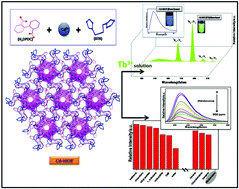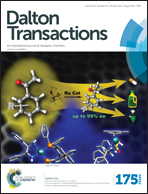A Cd(ii)-based metal–organic framework as a luminance sensor to nitrobenzene and Tb(iii) ion†
Abstract
A Cd(II)-based metal–organic framework, [Cd2(DPDC)2(BTB)]∞ (Cd-MOF, DPDC = 2,2′-diphenyldicarboxylate and BTB = 1,4-bis(1,2,4-triazol-1-yl)butane) was successfully constructed via a hydrothermal reaction. Structural analysis shows that the synthesized Cd-MOF is a three-dimensional (3D) architecture crystallized in the hexagonal system with a chiral space group P61. Powder X-ray diffraction experiments and thermogravimetric analysis reveal that the constructed Cd-MOF has a high chemical and thermal stability. A study of additional mechanical properties indicates that it exhibits a moderate stiffness with the average values of Young's modulus (E) and H as 11.3(2) and 0.9(7) GPa, respectively. The luminescence properties of the Cd-MOF were further studied. The result shows that it could be an effective sensor to the organic nitrobenzene molecule via a strong quenching effect, and also to the inorganic Tb(III) ion by a strong green emission effect. Moreover, when loading bimetal ions (Eu(III) and Tb(III)) into the Cd-MOF/methanol suspension, tunable visible luminescence can also be achieved by carefully adjusting the excitation wavelengths.


 Please wait while we load your content...
Please wait while we load your content...